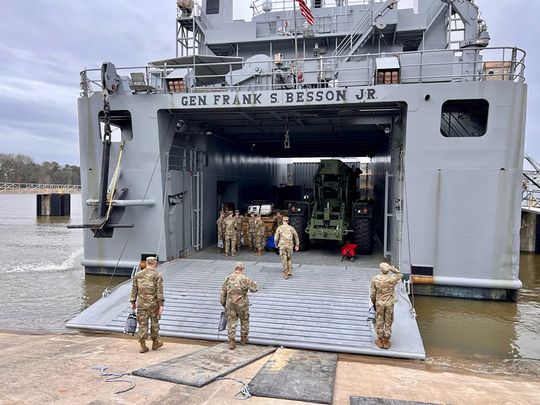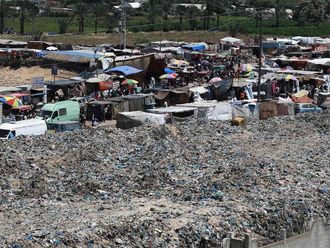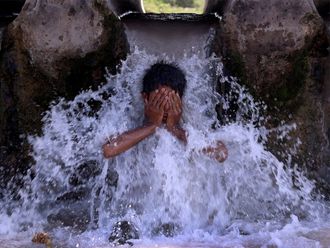
Washington: The US Army has despatched a ship to send humanitarian aid to Gaza, days after President Joe Biden vowed to build a temporary pier to supply the besieged enclave.
The General Frank S. Besson left Joint Base Langley-Eustis in Virginia “less than 36 hours after President Biden announced the US would provide humanitarian assistance to Gaza by sea,” Central Command (CENTCOM) said on Sunday, said in a statement.
The logistics support vessel is “carrying the first equipment to establish a temporary pier to deliver vital humanitarian supplies,” it said.
Biden’s announcement in his State of the Union address on Thursday followed UN warnings of widespread famine among Gaza’s 2.3 million Palestinians five months after Israel launched its offensive in the narrow strip in response to an attack by Hamas militants.
Gaza has no port infrastructure. The US initially plans to use Cyprus, which is offering a process for screening cargoes that will include Israel officials, removing the need for security checks in Gaza.
Most of Gaza’s people are now internally displaced, with severe bottlenecks in aid deliveries at land border checkpoints.
Gaza has been under an Israeli navy blockade since 2007, when Hamas took control of the enclave. There have been few direct sea arrivals since then.
Here’s what you need to know:
WHY NOW?
The UN has warned Gaza faces famine and has complained of “overwhelming obstacles” in getting in aid and distributing it around the enclave.
Aid agencies have implored Israel to ease access for relief supplies into Gaza and to give their convoys safe passage inside the territory.
Biden has meanwhile come under pressure from his Democratic Party to get close ally Israel to do more to let in relief supplies.
Israel has said there is no limit on the amount of humanitarian aid for civilians in Gaza and blames slow delivery on UN distribution capacity.
HOW IS AID GETTING IN NOW?
Most aid had been coming by road through the Rafah border crossing with Egypt and, since December, via the Kerem Shalom crossing with Israel, but the pace has been painfully slow.
The UN has complained of crossing closures, restrictions on movement and communication, onerous vetting procedures, unrest, damaged roads and unexploded ordnance as problems it faces importing and distributing supplies.
Some countries including the United States and Jordan have also started dropping in aid by air, though relief agencies say this is only possible in much smaller volumes than can come in by truck.
The European Commission has also said a maritime aid corridor from Cyprus to Gaza will start operating soon with help from the United Arab Emirates, but it has given no details how that will work.
HOW WILL THE TEMPORARY PORT WORK?
The US military will construct a floating pier and install it in place off Gaza. An official was quoted in US media saying it would be attached to land by a temporary causeway.
Aid will be shipped to it from Cyprus where Israeli officials will inspect it, as they currently do at the land borders, to stop anything going into Gaza that they deem to have a possible military use.
But with some parts of Gaza facing far worse problems than others, distribution inside the enclave may be the real challenge and there are no details on how that will work.
HOW LONG WILL IT TAKE?
Biden didn’t say but an official told Reuters it would take “a number of weeks to plan and execute”.
With hospitals in northern Gaza already reporting children dying of malnutrition, the temporary port plan does not look like an immediate solution for people who are already starving.
WHERE WILL IT BE BASED?
That’s not clear either. Most of Gaza’s coast is beach, and there may be limited locations where larger ships can approach without dredging.
Under the 1993 Oslo peace accords, European countries promised to build a seaport near Gaza City in the north of the enclave. But the idea fell apart when Palestinians staged an uprising against Israeli occupation in 2000 and there is now only a small fishing harbour there, unsuitable for large ships.
Israel militarily cut off north Gaza from the south early in the conflict and it stops people moving between them. Aid convoys have struggled to pass through Israeli checkpoints from the south into the north.
There is also a long jetty built into the sea near Khan Younis in the south that is normally used for fishing boats.
HOW WOULD SECURITY WORK?
Biden has promised that no US boots would touch the ground in Gaza and it is not clear if Israeli or other forces would provide security for the temporary port itself or for aid moving out into the enclave.
The issue of security has increasingly dogged all aid distribution in Gaza, with some convoys being surrounded by desperate people who removed the supplies.
Palestinian police stopped escorting convoys after what the UN described as “a spate of attacks by Israeli forces that led to police casualties”.
WHAT DOES EACH SIDE SAY ABOUT THE PLAN?
Israel says it “fully supports the deployment of a temporary dock” and promised “full cooperation between the two parties”.
Hamas has not yet responded to requests for comment on the idea.
Sigrid Kaag, the UN humanitarian and reconstruction coordinator for Gaza said “aid and sea is not a substitute for land and nobody says otherwise”.
The biggest UN agency operating in Gaza, UNRWA, welcomes the any effort that will “improve and increase the flow of much-needed humanitarian assistance” said its spokesperson Juliette Touma.
However, she added “there’s an easier, more efficient way of bringing in assistances and that is via the road crossings that connect Israel with Gaza”.










_resources1_16a30b3523c_small.jpg)

